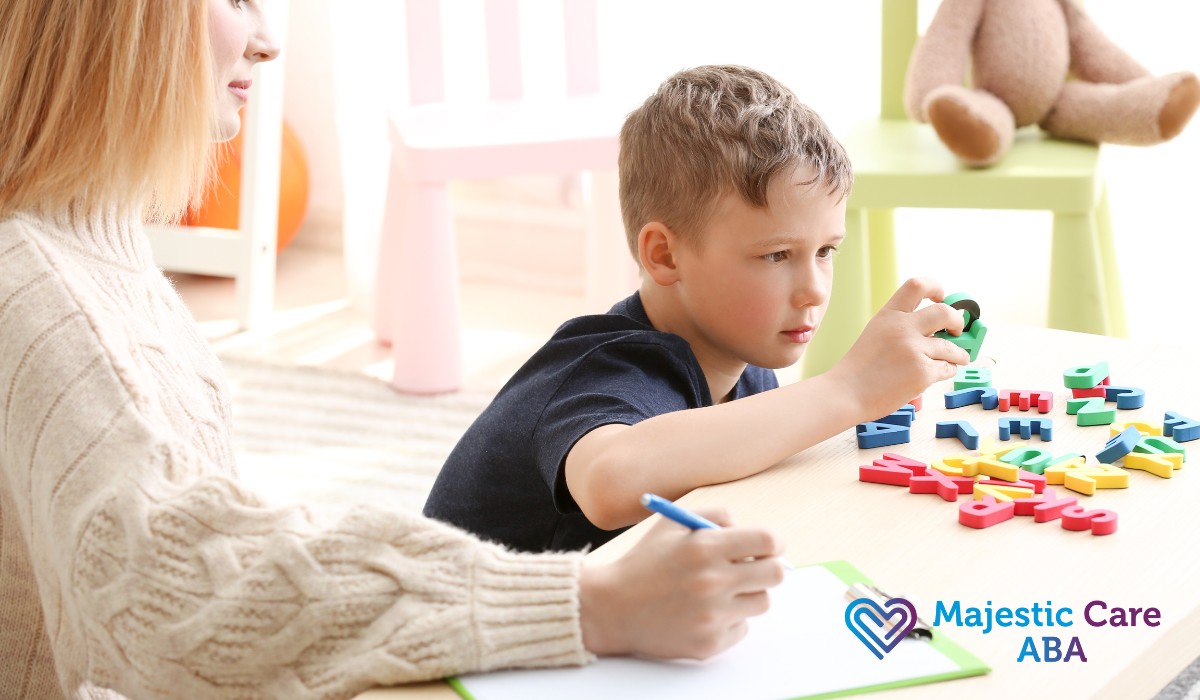Key Points:
- The DSM-5 consolidated multiple prior autism-related diagnoses (e.g. Asperger’s, PDD-NOS) into one “autism spectrum disorder (ASD)” diagnosis.
- The criteria shifted to two core domains (social communication + restricted/repetitive behaviors), introduced severity levels, and included sensory features.
- These changes matter because they help guide earlier detection, more precise therapy planning, and clearer communication with families and service systems.
For many parents, the autism diagnosis process can feel confusing and overwhelming. You may read about “Asperger’s,” “PDD-NOS,” or “autism spectrum,” and wonder what changed — and why it matters now. The Diagnostic and Statistical Manual of Mental Disorders, Fifth Edition (DSM-5) reshaped how professionals define and diagnose autism. Understanding what changed—and why those changes were made—can empower you to advocate better for your child when it comes to early detection, therapy planning (like ABA), and working with schools and clinicians.
In this article, we’ll walk you through how autism diagnosis under DSM-5 differs from earlier approaches, explore the rationale behind those changes, and explain why they matter in real life—especially for families seeking behavior therapy, early intervention, and clear support.
What Was the Diagnostic Landscape Before DSM-5?
Before 2013, under DSM-IV (and DSM-IV-TR), autism fell under a group called Pervasive Developmental Disorders (PDD). The main categories included:
- Autistic Disorder (classic autism)
- Asperger’s Disorder
- Pervasive Developmental Disorder – Not Otherwise Specified (PDD-NOS)
- Childhood Disintegrative Disorder
- Rett’s Disorder
Each of these carried its own criteria and labels. But clinicians and researchers began noticing inconsistency in applying them. People diagnosed with Asperger’s in one clinic might meet criteria for PDD-NOS in another. The distinctions were often blurry.
By consolidating under a single “Autism Spectrum Disorder,” the DSM-5 aimed to reduce confusion, standardize diagnosis, and reflect scientific consensus that these conditions lie along a spectrum.
Other key characteristics of the DSM-IV system:
- Three separate domains: social impairment, communication impairment, and restricted/repetitive behaviors.
- Rigid age-of-onset requirement: symptoms had to appear before age 3 in many cases.
- No formal severity specification: although clinicians acknowledged variation, the manual itself didn’t define required levels of support.
While DSM-IV facilitated many diagnoses over the years, its fragmentation and inconsistent usage led to calls for revision.

What Changed in DSM-5?
Before introducing the detailed criteria, here’s an introductory paragraph to frame the upcoming list of shifts:
The transition from DSM-IV to DSM-5 involved more than just renaming. It introduced structural changes to how autism is conceptualized and diagnosed. Below is a breakdown of the major changes — and what each means in practice.
1. Consolidation into a Single Autism Spectrum Disorder
With DSM-5, separate labels like Asperger’s, PDD-NOS, and classic autism were merged into one diagnosis: Autism Spectrum Disorder (ASD).
- Clinicians now indicate severity levels, support needs, and specifiers (e.g. with or without intellectual disability, with or without language impairment) rather than separate categorical diagnoses.
- This helps reduce ambiguity and allows clinicians to better reflect each child’s unique strengths and challenges.
2. Shift to Two Core Diagnostic Domains
Under DSM-5, autism is diagnosed via two major symptom domains instead of three:
- A. Social communication and social interaction
- B. Restricted, repetitive patterns of behavior, interests, or activities
Within Domain A, clinicians look for persistent deficits across:
- Social-emotional reciprocity
- Nonverbal communicative behaviors (e.g. eye contact, gestures)
- Developing, maintaining, and understanding relationships
In Domain B, at least two of four types of restricted/repetitive behaviors must be present:
- Stereotyped or repetitive motor movements, use of objects, or speech
- Insistence on sameness, inflexible routines, ritualized patterns
- Highly restricted, fixated interests
- Hyper- or hypo-reactivity to sensory input or unusual interest in sensory aspects of environment
Importantly, DSM-5 formally recognizes sensory features (e.g. sensitivity to sound, texture) as part of its diagnostic criteria — these were not explicit in DSM-IV.
3. “By History” and Broad Context
DSM-5 allows clinicians to consider presenting symptoms or history of symptoms (i.e. even if current behavior is masked or improved).
- This lets diagnosis apply even when, for example, a child has learned compensatory strategies or developed some adaptive skills over time.
- The criteria also emphasize that symptoms must appear in early development, even if not fully manifest until social demands increase.
4. Severity Levels and Specifiers
Rather than separate categorical labels, DSM-5 introduces three severity levels to describe required support:
- Level 1: Requiring support
- Level 2: Requiring substantial support
- Level 3: Requiring very substantial support
Additionally, clinicians assign specifiers such as:
- With or without accompanying intellectual impairment
- With or without language impairment
- Presence of associated features (e.g. ADHD, anxiety, medical conditions)
These specifiers help tailor intervention plans and clarify expectations.
5. Emphasis on Functioning & Support Needs
Rather than focusing solely on symptom presence, DSM-5 encourages clinicians to weigh functional impairment — how much the symptoms affect everyday life (home, school, social). This aligns diagnosis more closely with intervention planning and eligibility for services.
6. Introduction of Social Communication Disorder (SCD)
For individuals who show deficits in social communication but do not meet the repetitive/restricted behavior criteria, DSM-5 introduces Social Communication Disorder (SCD). This acknowledges that communication challenges can exist independently, separate from autism per se.
7. Minor Wording Clarification in DSM-5-TR (2022)
In the 2022 Text Revision (DSM-5-TR), one subtle but important tweak was made: the phrasing in Criterion A changed from “as manifested by the following” to “as manifested by all of the following.” This change reaffirms that deficits must be across all listed aspects, not just some, to reduce misinterpretation.
Why These Changes Matter
The shifts in DSM-5 were not arbitrary. They were driven by research, clinical experience, and practical concerns. Here’s how they matter for detection, therapy planning, and family navigation.
1. Better Consistency & Reduced Diagnostic Ambiguity
By unifying under ASD, clinicians can avoid semantic debates over whether a child “has Asperger’s or PDD-NOS.” Having a clear, spectrum-based term improves communication among professionals (psychologists, pediatricians, therapists) and helps families understand that autism is not one-size-fits-all.
2. Encouragement of Early and Flexible Diagnosis
Because DSM-5 allows history and evolving presentation, clinicians can diagnose earlier—even when behaviors are subtle or masked. That supports earlier intervention, which is often more effective.
However, some critics argue the stricter criteria may exclude very mild cases (especially girls or those with subtle social challenges).
3. More Tailored Therapy Planning
The addition of severity levels and specifiers allows behavior analysts, therapists, and educators to more precisely match support levels to each child’s current needs. Rather than “autism with language delay,” planning can now be “ASD, Level 2, with language impairment, co-occurring ADHD.”
4. Stronger Link between Diagnosis and Support Systems
Because DSM-5 emphasizes functional impairment, the diagnosis is more directly tied to eligibility for services (educational plans, insurance, early intervention). A clearer match between diagnosis and real-world needs helps reduce disputes over service access.
5. Inclusion of Sensory Features
Sensory challenges (e.g. overreacting to noise, textures) are common in autistic individuals, but previously undervalued in diagnostic frameworks. Now, they are explicit, giving families and therapists a more holistic picture of the child’s sensory and behavioral profile.
6. Recognition of Communication-Only Impairment
By creating Social Communication Disorder as a separate diagnosis, DSM-5 prevents over-diagnosis of autism in cases where repetitive behaviors are absent. This distinction helps tailor supports differently.
7. Impact on Research and Prevalence Estimates
The change in criteria meant that prevalence estimates and research participant pools had to adapt. Some studies show DSM-5 may reduce false positives compared to DSM-IV. Still, others express concern about excluding individuals who would have previously received support.

Practical Implications for Parents & Families
Understanding diagnostic shifts is one thing. Knowing what to do with that understanding is another. Here’s how the DSM-5 changes translate in practical parenting terms.
Using Criteria as a “Checklist” — with Caution
Even though clinicians use the DSM-5 criteria, you as a parent can monitor your child’s behavior using those two domains (social communication + restricted/repetitive). If your child shows consistent deficits in both areas over time, that suggests a red flag worth evaluating further.
Advocacy for Early Evaluation
Because DSM-5 allows diagnosis even when behaviors aren’t fully manifest, push for early screening (such as during pediatric checkups or developmental assessments). Early and accurate diagnosis gives you more time to begin interventions.
Ask for Specifiers & Severity Levels
When your child receives a diagnosis, ask what level and specifiers were assigned. That helps you understand what support might be needed now and later, and what interventions to prioritize.
Use the Diagnosis to Unlock Services
With a formal DSM-5 diagnosis, you can often qualify for:
- Special education services / Individualized Education Programs (IEPs)
- Early intervention programs
- Insurance or government-funded behavioral therapy (e.g. ABA)
- Support services (speech, occupational therapy, social skills groups)
Don’t Rely on Labels Alone
A diagnosis is a tool—not a limit. Two children with the same DSM-5 label may have widely different strengths, challenges, and pacing of progress. Use it with your therapy team to guide an individualized plan.
Be Aware of Gender and Cultural Variants
Because diagnostic criteria emphasize observable social-communication deficits and repetitive behaviors, some girls or children from cultures with differing social norms might mask traits and “fly under the radar.” If you sense something is off even without full criteria, advocate for more in-depth evaluation.

How This All Ties to ABA Therapy
Applied Behavior Analysis (ABA) is a widely used, evidence-based approach to support children with autism. Because DSM-5 more clearly frames the functional impairments of ASD (social, communication, restricted behaviors), ABA therapists can use the diagnosis and specifiers to build more targeted, individualized programs.
With clarity from DSM-5:
- ABA goals can directly address core ASD domains (e.g. social reciprocity, joint attention, reducing repetitive behaviors)
- Severity levels help therapists calibrate intensity and duration of interventions
- Specifiers (e.g. with language impairment) guide whether to prioritize pre-language or communication-based teaching
When diagnosis is accurate and timely, ABA therapy is more efficient—because your child’s intervention plan starts from a clearer baseline of challenges and strengths.
Limitations, Critiques & Areas for Future Improvement
No diagnostic system is perfect. It’s healthy to be aware of caveats.
- Potential exclusion of mild cases or females. Some families worry a child with milder traits may not meet criteria and thus lose access to services.
- Subjectivity in clinician interpretation. Even with standardized criteria, different evaluators may weigh behaviors differently.
- Overemphasis on deficits. Some autism advocates prefer a neurodiversity perspective focusing on strengths, not just impairments.
- Evolving science. As genetic, neurobiological, and phenotypic research deepens, future editions may refine diagnostic boundaries further.
- Overlap with other conditions. Autism often co-occurs with ADHD, anxiety, and intellectual disability. Clinicians must rule out or account for those in diagnosis and planning.
Despite these challenges, DSM-5 provides a more unified, research-informed foundation than its predecessors.
How ABA Therapy Supports Your Child’s Growth
The shift to DSM-5 in autism diagnosis brought meaningful restructuring: consolidating multiple prior diagnoses into a single Autism Spectrum Disorder, restructuring criteria into two core domains, formalizing severity levels and specifiers, and clarifying how early symptoms should be interpreted. These changes aim for consistency, earlier detection, better match to support systems, and clearer communication among clinicians, therapists, and families.
For parents, it means using the diagnosis as a tool—not a box—to guide early evaluation, advocacy, tailored therapy planning, and unlocking services.
If you’re searching for quality ABA therapy grounded in the context of this modern diagnostic framework, Majestic Care ABA is here to help. Our applied behavior analysis services are built on understanding each child’s DSM-5 profile and tailoring interventions based on severity, communication needs, sensory features, and functional goals.
Whether you’re in ABA therapy in Colorado, Indiana, or North Carolina—if your family is seeking compassionate, data-driven ABA therapy—reach out to us at Majestic Care ABA. We’d love to walk with you in translating diagnosis into meaningful progress.


